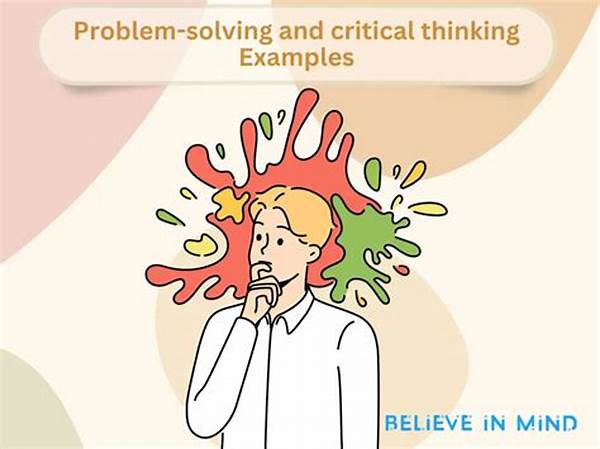Once upon a time in a bustling village named Crestwood, there was a curious little girl named Lily. Lily was known for her insatiable appetite for puzzles and mysteries. Her grandfather, a wise old man, often shared stories of how he used critical thinking and problem solving to outwit challenges during his youthful days. Inspired, Lily decided to master these skills, embarking on a journey to unravel the mysteries of her own.
Read Now : Structuring An Effective Acting Resume
The First Step to Mastery
Lily’s journey began with a simple challenge. Her grandfather presented her with an ancient map, rumored to lead to a hidden treasure within Crestwood. This wasn’t an ordinary map; it was filled with cryptic symbols and riddles. Initially, Lily felt overwhelmed. However, she remembered the tales of her grandfather using critical thinking and problem solving to crack even the toughest codes. Taking a deep breath, she began to decipher the symbols one by one. Her critical thinking enabled her to see patterns, and slowly, the map’s secrets unveiled themselves. By approaching each riddle with patience and a strategic mindset, she was able to solve parts of the puzzle that initially seemed impossible.
As Lily progressed, she encountered obstacles that demanded deeper thinking. A tricky part of the map required understanding the alignment of the stars—an area she knew little about. Lily recalled another story of her grandfather, where he faced a similar predicament. In that tale, he didn’t rush; instead, he spent nights observing the skies, slowly connecting the dots. Emulating him, Lily took time to study constellations. Her persistence paid off, as she successfully aligned the map with the night sky, furthering her on the path to the treasure. This experience taught her that critical thinking and problem solving often involve perseverance and learning beyond immediate boundaries.
Overcoming the Unexpected with Creativity
Not every problem can be tackled head-on, Lily soon learned. During her journey, she stumbled upon an unexpected challenge: a riddle written in an ancient language. Overwhelmed at first, she recalled her grandfather’s advice: creativity is often the key in critical thinking and problem solving. Determined, Lily sought help from the village librarian, who introduced her to old texts and translations. With newfound resources, she pieced together the meaning, discovering the path to the treasure was hidden in a melody—one only nature could play.
Using this newfound wisdom, Lily ventured into the woods, listening to the rustling leaves and chirping birds. The melody unlocked another piece of the puzzle. Success in critical thinking and problem solving, Lily understood, was not just about logic but also about creativity and resourcefulness. It was about being open to different perspectives and solutions, a lesson she would carry forward as she continued her exploration.
The Journey’s Lessons
The village of Crestwood soon buzzed with tales of Lily’s quest. Along the way, she encountered many villagers who offered advice and stories of their own adventures in critical thinking and problem solving. From each, she gleaned a new perspective. These interactions taught Lily that effective problem solving often involves collaboration, drawing from collective wisdom.
One day, Lily sat under the old oak tree, reflecting on her adventures. She realized that the treasure she sought wasn’t just the gold or jewels promised at the map’s end but the skills she had honed. Critical thinking and problem solving had become her new treasures, equipping her for challenges far beyond any map’s quest.
Applying Wisdom to Real Life
The skills Lily acquired on her journey didn’t remain confined to treasure hunting. In her daily life, challenges appeared in various forms, such as helping her friends resolve quarrels or finding innovative ways to improve the small village school. Each time, she applied critical thinking and problem solving, approaching issues from different angles and considering all possibilities before making decisions.
Read Now : **improving Diction In Vocal Performance**
Critical thinking and problem solving had turned Lily into a beloved figure in Crestwood. Her story spread, inspiring others to venture beyond their comfort zones, to approach life’s challenges with a critical eye and a problem-solver’s heart. In doing so, the village as a whole became a place where barriers were opportunities and every problem a mystery waiting to be solved.
The Treasure of Knowledge
As years passed, Lily became known as the wise woman of Crestwood. Grandchildren of the villagers frequently gathered at her feet, eager for stories of her adventures. Lily gladly shared her tales, embedding lessons of critical thinking and problem solving in each narrative. She encouraged the young ones to think independently, ask questions, and never shy away from challenges.
Crestwood thrived as a community because its people embraced critical thinking and problem solving, qualities that kept old problems at bay and welcomed new solutions. They learned that the real treasure lay in the process of thinking critically and solving problems creatively. It was this wisdom Lily imparted to the next generation, ensuring that her legendary journey would inspire quests of discovery for years to come.
Reflection and Legacy
Looking back, Lily marveled at how a simple map had transformed her life. It was more than a guide to a treasure; it was a key to unlocking her potential. Her journey emphasized the timeless value of critical thinking and problem solving, skills that were not only applicable to adventurous quests but to everyday challenges. Her story became a cornerstone of Crestwood’s ethos, a reminder that critical thinking and problem solving can guide anyone to new frontiers of possibility and growth.
